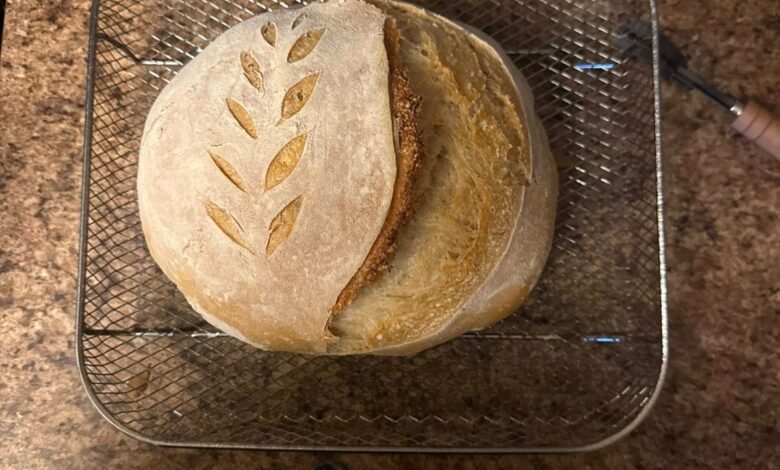The Fluffiest Sourdough Bread

Introduction
There’s something truly special about a freshly baked sourdough loaf. With its chewy texture, crisp crust, and mildly tangy flavor, sourdough bread has earned its place as a timeless favorite in kitchens worldwide. Unlike ordinary bread, sourdough relies on natural fermentation, giving it a distinct character and depth of taste.
Making sourdough at home may sound intimidating, but it’s actually a rewarding process that combines patience and tradition. Once you get the hang of it, the ritual of feeding your starter, kneading the dough, and waiting for it to rise becomes a relaxing and enjoyable routine.
Whether you’re baking for breakfast toast, hearty sandwiches, or simply to enjoy with butter, a homemade sourdough loaf will elevate any meal. This recipe will guide you step-by-step so you can achieve bakery-quality results right in your own kitchen.
Cooking Time and Serving
- Preparation time (including fermentation): 12–18 hours
- Baking time: 40–45 minutes
- Total time: Approximately 14–20 hours (mostly resting/rising time)
- Servings: 1 large loaf (about 12 slices)
Ingredients (for 1 Loaf)
- 500 g (4 cups) bread flour
- 350 g (1 ½ cups) water (room temperature)
- 100 g (½ cup) active sourdough starter
- 10 g (2 tsp) salt
How to Make a Sourdough Loaf
Step 1: Prepare the Dough
- In a large mixing bowl, combine the sourdough starter and water. Stir until the starter dissolves.
- Add the flour and mix until a rough dough forms. Cover with a damp cloth and let it rest for 30 minutes (autolyse).
Step 2: Add Salt & Stretch
- Sprinkle salt over the dough and mix well.
- Over the next 3–4 hours, perform stretch and folds every 30 minutes: grab one side of the dough, stretch it upward, and fold it back over. This strengthens the gluten.
Step 3: Bulk Fermentation
- Cover the bowl and let the dough rise at room temperature for 8–12 hours, or until doubled in size.
Step 4: Shape the Loaf
- Lightly flour a surface and gently turn the dough out. Shape it into a round or oval loaf.
- Place it seam-side up in a floured banneton (or a bowl lined with a floured kitchen towel). Cover and refrigerate overnight for a cold proof (8–12 hours).
Step 5: Bake the Bread
- Preheat your oven to 475°F (245°C) with a Dutch oven inside for at least 30 minutes.
- Place the dough seam-side down into the hot Dutch oven, score the top with a sharp blade, cover, and bake for 20 minutes.
- Remove the lid and bake for another 20–25 minutes, until golden brown and crusty.
- Cool completely on a wire rack before slicing.
Notes
- Always use an active, bubbly starter for best results.
- Hydration levels may vary depending on flour type—adjust water if dough feels too dry or too sticky.
- A Dutch oven traps steam, giving the loaf its signature crust, but you can also bake on a preheated baking stone with a pan of water for steam.
- Sourdough flavor deepens with a longer cold proof—don’t rush the process!
FAQs
Q1: Can I use whole wheat flour instead of bread flour?
Yes, you can substitute part or all of the flour with whole wheat. However, whole wheat absorbs more water, so you may need to slightly increase hydration.
Q2: Why is my sourdough dense?
Dense loaves usually result from under-proofing, inactive starter, or not enough gluten development. Make sure your starter is active and bubbly before baking.
Q3: How long does sourdough bread stay fresh?
Sourdough stays fresh for about 3–4 days at room temperature. Store in a bread bag or wrap in a towel. It also freezes well for up to 2 months.
Nutrition Information (Per Serving, 1 Slice out of 12)
- Calories: 170
- Carbohydrates: 34 g
- Protein: 6 g
- Fat: 0.5 g
- Fiber: 2 g
- Sugar: 0 g
- Sodium: 160 mg
Disclaimer
This sourdough loaf is best enjoyed in moderation as part of a balanced diet. If you have gluten sensitivity, wheat allergy, or celiac disease, please avoid this recipe or use a certified gluten-free alternative. Always consult a healthcare provider if unsure about dietary restrictions.




